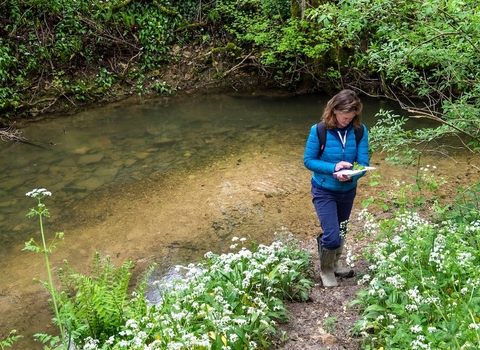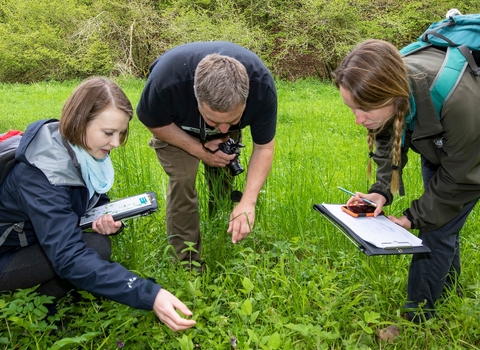Mapping and monitoring Gloucestershire's habitats to aid nature's recovery
Woodland • Grassland • River • Heathland
Cropland • Wetland • Garden • Orchard
Knowing what grows where is fundamental to restoring nature and protecting against climate change.
Gloucestershire Wildlife Trust are leading on tackling the ecological crisis with a citizen science programme to map and monitor the county's habitats.
What is HabiMap?
HabiMap is a rolling citizen science programme to carry out detailed surveys of all habitats across Gloucestershire every 10 years.
In 2020 the Glos Natural Capital mapping project was published, showing the Nature Recovery Network (NRN) of woodland, wetland and open habitat connectivity across the county, and ecosystem services (ES) being delivered by habitats.
These maps are created from local and national data sets including satellite mapping, but some of this is old and satellite mapping can’t determine habitat quality – for example it doesn’t separate reseeded rye grassland from wildflower pasture, or show what is growing under woodland trees.
HabiMap is ground truthing and renewing the data behind these maps as evidence to support nature's recovery.
HabiMap benefits
Free HabiMap citizen science surveys will improve the accuracy of the data that can be used by landowners, farmers and communities to inform environmental decisions.
Accurate habitat maps are increasingly vital in tackling the ecological crisis and will help communities, landowners, and farmers to make decisions about investing in:
- ‘Public goods’ such as clean air and water, and flood management
- Carbon capture schemes such as hedge planting to help control soil erosion and CO2.
- Wildlife conservation and ‘rewilding’.
- Land banking and development
- Farming schemes such as ELMS.
Who is involved?
HabiMap is led by three GWT staff and in 2021, a year after inception, it had 200 citizen scientist volunteers, with more coming forward each month.
People getting involved in HabiMap are usually either:
- People volunteering as citizen scientists.
- Landowners and farmers looking to have land surveyed.

HabiMap woodland survey at GWT Siccaridge reserve (c)Nick Turner 2021
Background and further information
In 2010 the government published the influential ‘Making Space for Nature’, often known as the Lawton Report.
The report proposed the principle that to halt and reverse environmental loss areas for nature needed to be 'Bigger, Better Managed and More Connected.'
As part of putting this idea into practice, in 2018 the government published a 25 year Environment Plan which aspired to create a national Nature Recovery Network (NRN) through existing Local Nature Partnerships.
Gloucestershire Wildlife Trust, working as part of the Gloucestershire Local Nature Partnership, supported the setting up of the Gloucestershire Nature Recovery Network.
In 2020 the NRN Mapping Project published maps including a Environmental Services map and a Habitat map for the county, based on best available data but much of that data is too old or unclear.
Using the new UK Habitat Classification System (UKHab), HabiMap is improving habitat data quality to identify opportunities to enhance, create and connect wildlife-rich habitats across Gloucestershire.
HabiMap is aiming for three levels of detail:
- Habitat survey of all of Gloucestershire on a 10 year rolling programme to a minimum of UK Habs level three or four.
- 10 Priority Landscape Areas (over 17,000 ha) to be habitat mapped to UK Habs level four or five and monitored for ecological integrity data every three years.
- All GWT Nature Reserves (over 1,000 ha) to be condition monitored using bespoke habitat mapping methodology every three years.
The data will be analysed and reported through technical mapping (QGIS) and a land management database (CMSI) to help organisations across Gloucestershire to focus limited resources.

Wet meadow and beech woodland habitats border the River Frome in GWT Sapperton Valley nature reserve (c) Nick Turner



